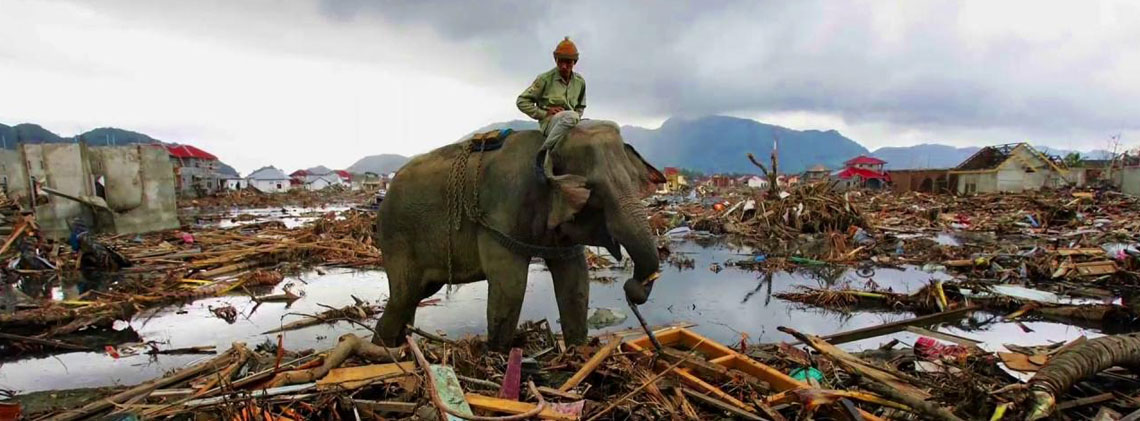
Response and Recovery in India after the December 2004 Great Sumatra Earthquake and Indian Ocean Tsunami
- December 2004
- Chennai, India
- On Sunday, Dec. 26, 2004, a 9.0-magnitude earthquake and tsunami caused incredible destruction and loss of life across five time zones and 14 countries bordering the Indian Ocean.
- More than 225,000 people were killed, thousands were injured, and 1.7 million people were left homeless.
The Story of Devastation and Disbelief:
On the night of December 26, 2004, a massive quake of magnitude 9.1-9.3 — with its epicentre in Bay of Bengal — triggered one of the biggest Tsunamis the world had ever witnessed. The massive waves, measuring up to 30 meters, created havoc in 15 different countries killing more than 2,00,000 people. More than half of those who perished in the calamity belonged to Indonesia.The earthquake, which had its epicentre 257 km south-southwest of Banda Aceh, Sumatra, measured 8.9 on the Richter scale making it the most powerful in the world in the last 40 years. At least 2,200 people were killed in and around Sumatra by floods and collapsing buildings, officials said. But, most of the destruction was caused by seismic waves or tsunami that hit India, Sri Lanka, Malaysia and Thailand within two hours of the first impact of the quake.
Fishermen, tourists and people living on the coast were unprepared for the waves that rose as high as six metres (20 feet) throughout the Indian Ocean and the Andaman Sea. In India, more than 3,000 people were killed in Tamil Nadu, Pondicherry, Andhra Pradesh and Kerala. Tamil Nadu alone accounted for 1,705 deaths. The toll is expected to rise. In Chennai, early morning walkers and children playing cricket on the beach were washed away. The toll: 131. Nagapattinam was worst hit in the State with the toll put at 788. In Kanniyakumari, 392 people died. Late reports said at least 1,000 people had died in the Andamans. Pondicherry reported 280 deaths, 211 in Karaikal alone. In Kerala, at least 100 people have died. The toll in Andhra Pradesh was 84.
Sri Lanka, whose capital, Colombo, is 1,806 km west of the epicentre, suffered extensive damage with reports putting the number of people killed at 4,500. One million more were affected by the surging seawater that flooded coastal towns including Colombo. The Government called Sunday's events a national disaster and appealed for emergency relief.
Nearly 300 were confirmed dead in Thailand, among them holiday revellers from around the world. The toll in Malaysia was 428, including foreign tourists. Thousands of people, mostly fishermen, were reported missing. The United States Geological Survey recorded the magnitude 8.9 earthquake off Sumatra as lying centred 10 km below the seabed. Aftershocks struck in the magnitude 7 range.
The earthquake was the world's fifth most powerful since 1900 and the strongest since a 9.2 temblor slammed Alaska in 1964, U.S. earthquake experts said. The quake occurred at a place where several massive geological plates push against each other with massive force. The survey said a 1,000-kilometer (620-mile) section along the boundary of the plates shifted, motion that triggered the sudden displacement of a huge volume of water.
Fishermen and their dependents were the hardest hit due to the lack of warning, lack of buyers for the fish, loss of boats, and loss of huts. Dead fish were seen floating the next day at Visakhapatnam, in the port and fishing harbor. The business of fishermen was constrained by the damage to fishing nets and other fishing-related equipment. The affected coast of India has two fishing communities: the Pattinavars along the Bay of Ben- gal and the Mukkuvas along the Kanyakumari area, and fishing is the only livelihood of these communities. Thus they cannot easily abandon fishing. This is in contrast to the Indonesian fishermen, who have a parallel profession in agriculture. The loss of family and property caused trauma to the fishermen, and they did not resume fishing. Their livelihood was severely affected. The immediate need for food was fulfilled by the government’s relief package. But the loss of the fishing equipment was a bottleneck. In cases where the equipment was in order, the families were concerned about other issues, and this prevented the fishermen from going back to the high seas. In general, the number of damaged boats was smaller than the number of damaged nets. This was because typically a fishing net needs to remain wet in the water, but after the tsunami the nets were washed ashore and remained dry for days.
Our Charity Work in Kerala and Tamil Nadu
We collected and gave livelihood restoration compensation to the fishermen:- Replacement of 100 gill nets for motorized boats at Rs. 20,000; US $440/per unit.
- Replacement of 100 gill nets for wooden boats at Rs. 10,000; US $220/per unit.
- Repair/rebuilding of 100 motorized boats at Rs. 15,000; US $330/per unit.
- Repair/rebuilding of 20,000 wooden boats at Rs. 5,000; US $110/per unit.
